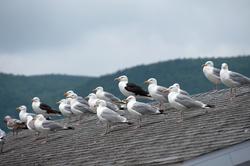 If you own or manage a rooftop nightclub, you know that birds can be a problem. Before you open, these flying pests can leave droppings all over your tables, sofas and chairs, leaving you with a nasty cleanup job. If your club features a pool or spa, bird droppings can pose a real headache, requiring an expensive cleanup. After you open, when guests start streaming in, the presence of birds on tables, chairs and sofas can be a turn off. Birds are attracted to your club because of all the finger foods on tables and scraps that have fallen on the floor. You also need to keep birds away from decorations, signage, bar areas, lighting fixtures and sound equipment. No matter how you look at it, without effective bird deterrents, you’ll be at the mercy of pest birds that can quickly ruin the image of your club. Fortunately, there are some very effective bird deterrents you can install that will keep birds away from your club. Here are three today’s bird control experts recommend: 1. Bird Spikes Proven worldwide, Bird Spikes are the anti-perching, anti-roosting devices that will keep birds off signage, light posts, awnings, fixed umbrellas, rooflines and virtually any elevated structure. Today’s plastic bird spikes come in a rainbow of colors—including crystal clear, brick red, light grey, brown, black and tan—to blend in with your club’s façade. The best plastic bird spikes are made of rigid UV-resistant unbreakable polycarbonate to resist weathering and sun exposure. These spikes come in 3-, 5- and 7-inch widths to protect areas up to 7 inches wide. The base of the spiked strip is just 1.5” wide, so it’s easily installed on narrow fixtures. 2. Bird Chase Super Sonic Easy to set up, the Bird Chase Super Sonic broadcasts predator and distress calls that frighten birds away. The Bird Chase device can be set up to emit distress and predator calls day and night. And it can broadcast distress and predator calls for as many as 22 different types of birds. So one device takes care of all your bird problems. Incidentally, these sounds are not annoying to humans, since they resemble natural birdcalls. And unlike ultrasonic devices, the Bird Chase device emits sounds birds can actually hear. 3. Plastic Bird Netting Easy to install, Plastic Bird Netting can be used to deny pest birds access to overhangs, canopies, and electrical control and food storage areas. Bird netting is available in several mesh sizes to deter various types and sizes of birds. For larger birds, like pigeons or seagulls, a 1-1/8-inch to 2-inch mesh size is recommended; for sparrows or starlings, a 3/4-inch mesh size would do. The best bird netting is UV- stabilized, flame resistant and rot- and water-proof. Bird netting is even available in different colors--like white, stone and black, so it’s barely visible.

There are about 146,000 retail gas stations and convenience stores in the United States. That's the good news for late-night shoppers and folks running out of gas. The bad news is, many of these stores lack effective pigeon control, which means feral pigeons can pretty much do what they please.
The last thing customers want to touch is a pump handle covered with pigeon poop. Or see the roof or hood of their car splattered with poop when they return with snacks in hand. Theses stores have a pigeon problem because the pesky little birds love to roost in gas station and store canopies. And they do so hundreds at a time.
Without effective pigeon control measures, this often-neglected nuisance can cost commercial property owners thousands of dollars in maintenance and repairs. Keep in mind that just one healthy pigeon creates an average 66 pounds of droppings each year. If you've got a flock of these birds nesting in your gas station canopy, you're looking at several tons of poop over a short period of time.
If you think the damage is all cosmetic, consider what happened to a gas station canopy in Yuma, Arizona. A build-up of pigeon poop clogged up the canopy's drains, causing it to crash to the ground after a heavy rain. A Hummer and a BMW were smashed in the process. Needless to say the gas station owner's insurance policy went up.
Roosting and nesting pigeons can create an unsightly mess on signage, windows and gas pumps. They can clog drains, block out security cameras and jam doors and windows. They can also wreak havoc with rooftop AC units.
As if that weren't enough to implement aggressive pigeon control measures, pigeon droppings are also breeding grounds for a number of diseases. Fecal droppings in pigeon infested canopies can create an environment for bacteria and fungi spores to grow and multiply. This filth can attract mites, black widows, rats, mice and other vermin.
Consider the problems such an environment presents to a gas station that has a full-service food preparation kitchen. If you've got flocks of pigeons gathering on your rooftop or near air induction vents, these air conditioning and air circulation systems could easily suck in pigeon dander, spores and viruses.
Cleaning roofs, parapets, HVAC, ventilation systems and other roosting sites can aerate these areas and increase the risks of exposure to disease. Gas station and store canopies offer the ideal place for pigeons—plenty of food in garbage cans and safe roosting areas.
Failure to implement pigeon control measures can be very expensive in the long run—repairing a canopy can set you back as much as $100,000. And that doesn't include lost sales, city or health violation fees or full canopy replacement.
Some effective pigeon control measures include bird netting, which works to effectively exclude the pests. You can also use chemical fogging systems to drive out entrenched flocks. Both measures are safe to use on pigeons and will save you a lot of grief and expense.

by Alex A. Kecskes
Dozens of filthy pigeons recently invaded the Food Court above the Roma Street Railway Station, creating a health hazard just outside KFC, McDonald's and Donut King. At the Delta Airlines terminal at JFK Airport, pigeons seemed to be everywhere in the food court area, snatching up food and leaving their disease-carrying droppings.
A food court patron in another city accidentally spilled some taco meat on a table and was besieged by a dozen or so pigeons. The filthy birds pulled out all the stops to steal his food. They came out of nowhere, jumping on the table, flying and hovering around him in a panicked effort to devour the precious bits of ground beef. Customers nearby urged him to swat the persistent birds, which he did while trying to hold on to the remains of his taco. The pigeons were extremely aggressive, jumping on and hovering around his hand, pecking at and trying to snatch the taco from his grasp. The determined birds even tried to peck at the taco he was still in the process of chewing. Fortunately, a few solid backhands sent the birds fleeing to another table.
If you’re a food court manager or owner, you can’t afford to have pigeons and other flying pests harassing your customers. Especially in these tough economic times when consumers are cutting back on going out to eat. Pigeons snatching up food from tables and chairs and leaving droppings after they’re done can be a costly health violation. Pest birds, as most health inspectors will tell you, can carry any of 60 known diseases.
To keep pigeons and other pest birds out of food court areas, you must implement an effective bird control strategy. This may involve the use of several bird deterrents to keep persistent birds like pigeons away. Some of the more proven effective bird control measures include:
Pigeon Spikes. These can be placed immediately outside of food court areas to deny pigeons a place to land. If they can’t land, they can’t perch and observe, which is what all pest birds do before they “move in for the kill.” Bird spikes come in rigid U.V.-resistant unbreakable polycarbonate spikes or high-strength, durable stainless steel. You can even order them in different colors--including white, tan, gray, black, brown, brick red and crystal clear to match the décor of your food court. One manufacturer offers a stainless steel spike with a patented “bend-and-crush” design. The best pigeon spikes feature a unique “no-nest” design with no-gap spacing to deter birds from roosting or landing. If your food court has rain gutters outside, these may be infested with pigeon nests. To keep pest birds out of these areas, you’ll need a special kind of bird spike called a Gutter Bird Spike, which is specially designed to fit onto gutters.
No-Knot Bird Netting. Here, again, you want to deny pest birds like pigeons from entering food courts and other areas where food is being prepared or served. This particular netting is low profile, lightweight and easy to handle and install. It comes in several stock sizes and custom cuts. No-Knot bird netting is also tough and resilient with a 10-year guarantee. It’s non-conductive and made of flame resistant, multi-strand polypropylene fiber. (Polypropylene is chemically inert and will resist the influence of many chemicals at ordinary temperatures.) The best bird netting is ISO 1806 Protocol mesh tested. It won’t rot, absorb water, or mildew, and it should have built-in U.V. inhibitors to hold up under years of tough weather.
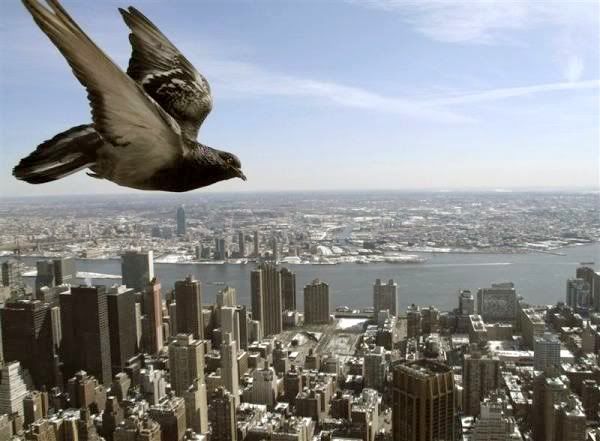
New York City is home to over 1 million pigeons. They mate for life, nest on windowsills, swoop down for scraps of food, and leave droppings on the shoulders of hapless pedestrians. Here, pigeon control is a must.
New Yorkers will tell you that the pigeon problem is everywhere. At brunch style outdoor restaurants, they silently wiggle their way beneath the tables and chairs. One can barely cross his or her legs without the risk of brushing a foot against the filthy birds. They bob and weave and hysterically flap their wings at the slightest irritation. Yes, you can shoo them away with a menu or a napkin, but they come right back. At some restaurants, they've developed the nerve to hop onto empty tables or lounge on the backs of chairs. They've even been known to take food from a child's hand. Without pigeon control, things can get pretty chaotic.
At the Staten Island Ferry Terminal, pigeons have a nasty habit of snatching away breakfasts and defecating on commuters. Urban pigeons dominate city plazas, street-side cafes and monuments. Their droppings plaster Times Square in New York, where they peck endlessly at crumbs or leftover food.
Not helping matters are the people who love to feed the pigeons near commercial food establishments. They draw pigeons to these stores and restaurants creating a nuisance for customers. In some stores, the smells and bacteria from the pigeons are sucked through the ventilation system and can literally cause patrons to leave the store. Pigeon control here is strongly recommended.
Outside, in areas like Times Square and other major intersections, food cart vendors complain of pigeons annoying customers and interfering with business transactions. The smells of pigeons and their droppings near a food cart can be quite overwhelming.
Storeowners in the Big Apple also complain of dead pigeons on sidewalks and entryways to their establishments. Air conditioning units, gutters and downspouts are often clogged with pigeon feathers and nests, causing AC units to jam up and roofs to leak. Pigeon control can save storeowners hundreds, even thousands of dollars.
For commercial property owners who have an occasional pigeon problem or are simply bothered by a few pigeons, a Bird Motel will often suffice. These catch-and-release pigeon control motels are ideal for relocating just a few annoying pigeons. They can be placed virtually anywhere pigeons like to gather. The best motels feature an easy-access door and are constructed of galvanized wire so they won't rust or corrode.
If, on the other hand, you have a store sign or ledge that attracts pigeons by the dozen, you might look into installing some Bird Spikes. The king of pigeon control devices, bird spikes keep virtually any flying pest from landing. To assuage your bird loving customers, they are harmless to birds, pets and people. Spikes come in either rigid U.V.-resistant unbreakable polycarbonate or the longer-lasting, slightly more expensive stainless steel models. You can even get spikes in a variety of colors--including white, tan, gray, black, brown, brick red and crystal clear. The spikes are easily glued or screwed to any surface. The Big Apple is beautiful with the right pigeon control.
by Alex A. Kecskes The ubiquitous pigeon has been man's friend and foe for centuries. Rising to nuisance level as they invaded our cities and towns, pest pigeons cause over one billion dollars annually in damage and cleanup costs. It's not surprising. Pigeon poop alone can cause all sorts of damage. It can eat into wood and metal, ruin fine stonework, and seize up AC units. Worse yet, pigeon poop is teaming with bacteria, fungi and parasites, which is why it poses such a high health risk. After all, pigeon droppings have been known to carry any of 60 known diseases. And no less hazardous are the fleas, mites and ticks that infest pigeons. It's no wonder that pigeon control has become so important. Thankfully, there are a number of highly effective pigeon controlmethods on the market.. One can't talk about pigeon control without mentioning the various Bird Scare products currently available. These flash tape banners wave, flap and crackle in the breeze to frighten pigeons looking for a safe place to land and roost. The same holds true for the inflatable, Bird Scare Balloon. Imprinted with menacing looking predator eyes, these devices turn and flail in the breeze to frighten pest pigeons away. They check in and they check out. That's the principle behind our next pigeon control device--the Bird Motel. The live-trap cages are quite good at catching pest pigeons and are ideal for use on rooftops, courtyards and other areas where birds tend to gather. And once they're caught, a handy easy-access door lets you reach in and release them to a more remote location. The better motels are made of tough galvanized wire and you can use them indoors or out. The traps come in various sizes to capture various size pigeons. Next up--Bird Wire Systems. These nifty pigeon control arrays incorporate a post and wire system to create a wobbly landing site for pigeons. The low-profile systems are ideal for keeping pigeons off ledges, parapet walls, rooflines, handrails and similar areas. Pigeons don't like to land on anything unstable and will quickly move on to more solid footing. Humane and economical, bird wire systemshave been approved for use on Federal and State government structures. The best systems use nylon coated stainless steel wire, which holds up better in punishing weather. Called the granddaddy of pigeon control--and bird control, for that matter--the Bird Spike has saved more signs, buildings street lights, and AC units than perhaps any other anti-pest bird device. Pigeons just won't land near the threatening looking spikes. You can get rigid U.V.-resistant unbreakable polycarbonate spikes, or opt for longer lasting slightly more expensive stainless steel spikes. The stainless steel bird spikes are available in a non-reflective metal finish and are often recommended by architects, contractors and government agencies. Installation is easy for they can be glued or nailed down to virtually any surface. They even come in a selection of colors so they'll blend in with your building's exterior décor. So successful are spikes as a pigeon control device that they have morphed in design to fit specific applications. For example, you can now get Girder Spikes, which will keep pigeons and larger pest birds from landing on girders or I-beams. They come with adjustable “C-clamps” to fit any size girder. There's also the Gutter Spike, ideal for preventing pigeons from landing and roosting in rain gutters. Another pigeon control device that's shocking in its ability to deter pest pigeons is the Electric Track. Ideal for discouraging pigeons from settling on ledges, rooflines, parapet walls, signs, I-beams, and flat or curved surfaces, these electrified tracks impart a mild electric zap to a bird's foot. Electric tracks are easily mounted on any flat or curved surface. The best are low profile in design and virtually invisible to anyone looking up from ground level. Somewhat entertaining to watch as birds try unsuccessfully to land on it, the Bird Slope has proven itself a worthy adversary to the determined pest pigeon. Essentially just a slippery, angled PVC panel, pigeons just slide off them faster than you can say pest pigeon. It doesn't take long for pigeons to decide, this is a no-landing zone and leave. Bird slopes are ideal for beams, ledges, eaves, and other L-shaped areas where pigeons like to nest and roost. The panels come in several colors. Opt for UV stabilized polycarbonate panels if you can, as they will last longer. If you believe only barrier deterrents will suit your application, you might try Bird Nettingas a means of pigeon control. While pest pigeons may be able to land on these, they won't be able to get through. Netting is ideal for sealing off rooftops, courtyards, patio covers, and other large areas, including groves and vineyards. The finest netting is ISO 1806 mesh test polyethylene fabric. For rugged outdoor use, opt for U.V. stabilized, flame resistant and rot and waterproof netting. If the sounds of pest pigeons landing on your property annoy you, you can now fight back with sound. Known as Sonic Repeller, these pigeon control devices produce a variety of annoying distress and predator calls only pigeons can hear. Ideal for a wide range of outdoor applications, these systems are easy to set up and install. Our next pigeon control solutionis actually a gel--called Bird Gel. Humane and highly effective, this chemical skins over but never really dries. When pigeons land on it, they can't wait to leave. The icky, sticky surface is one thing most birds, including pigeons, can't stand. The gel is easily applied to any surface using a caulking gun. Pest pigeons really hate this next pigeon control device. Called the Scarecrow, it's basically a motion-activated sprinkler that blasts a jet of water whenever it senses a pigeon approaching. The sudden burst of water combined with the scarecrow's moving head and the sprinkler sound--all unite to create a formidable deterrent. It's the perfect solution to deter pest pigeonsfrom gardens, pools, spas, backyards, and other outdoor areas.
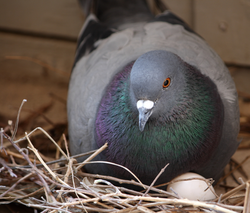 by Alex A. Kecskes
Except for the polar ice caps, the ubiquitous pigeon (sometimes called rock dove) is just about everywhere on the planet. Feral pigeons live in close association with humans, yet they possess the characteristics of highly adapted wild birds. Pigeons typically feed on seeds but they can easily survive on vegetables, meat and other food discarded by humans. Nests are built by the female using material collected by the male.
If you want to keep pigeons from nesting on your property, you’ll have to eliminate their sources of food, water and shelter. When pigeons are on the lookout for places to nest, they’ll first make sure there’s plenty to eat for themselves and their young. If you own or manage a restaurant, particularly, an outdoor eatery, you’ll need to be ever vigilant about food scraps under tables, benches and chairs. The same holds true of dipsy-dumpsters--keep the lids closed and clean up any food around them. Also eliminate any sources of standing water left by sprinklers and maintenance crews.
In terms of shelter, feral pigeons often build their nests in hard-to-reach places, such as covered crevices along building ledges, in the nooks and crannies of building beams and rafters, or in other hidden-away places. Sometimes they’ll use very little nesting material and lay their eggs on bare ground. Nests are usually hard to find and often used over and over. Loose tiles and broken windows will give pigeons easy access to nesting spots. Pigeons are particularly fond of roof spaces, especially those that have open water tanks. In general, gutters, window air conditioners (in particular, empty air conditioner containment boxes), chimney pots and external ledges serve as ideal nesting sites.
 by Fran Prisco Pigeons have become public enemy number one in many large cities. They are in public parks, food courts, and landing or roosting on public buildings. Each year governments and municipalities spend thousands of dollars cleaning up after and repairing damage caused by pigeons. Pigeon droppings are acidic and can damage building materials as well as carry any of 60 different diseases. Bird droppings are also slippery and a big cause of slip and fall accidents on sidewalks and building walkways. It is important that the public feel protected from illness as well as physical harm when using public facilities. To get rid of pigeons from public areas, the pigeon spike is the answer. Pigeon spikes keep pest pigeons from landing and roosting on flat and curved surfaces such as roof ledges, windowsills even channel letters. The best pigeon spikes come are made from polycarbonate plastic with built in U.V. protectors for long life. They are manufactured in two-foot sections for easy and quick installation. Installing Pigeon Spikes Before installing any type of bird control product or system, it is important to do a thorough clean up. All debris and droppings left behind by the birds must be removed. It may be necessary to power wash the area to remove bird droppings and other debris before installing the pigeon spikes. A clean surface is needed in order for the spikes to adhere to the surface being treated when installing with adhesive. Pigeon spikes are easily installed using glue, screws or tie downs. When using glue, choose a construction grade adhesive that will keep the spikes in place regardless of weather or temperatures. It is important that the entire surface be covered with the spikes. If there is space of more than an inch in front of or behind the spikes, pigeons will be able to land and use the spikes to drop nesting materials and make nests. Once installed the pigeon spikes are virtually invisible and will not take away from the building aesthetics. Pigeon spikes are practically maintenance free. It is a good idea to inspect the spikes periodically to be sure there is not a build up of leaves or twigs in the spikes, or that they have not come loose. Related articles 
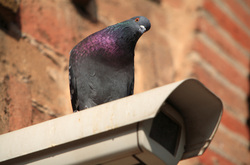 by Alex A. Kecskes Today, more architects than ever are integrating pigeon control measures into their building designs. They know that the image of beautiful arches, clean lines and walls of glass can quickly be ruined by bird droppings. They also know that the acid in bird droppings can eat into wood, composites and even stone surfaces to permanently damage areas that were once showpieces of design. The fact is, many clients ask for references when contracting architects. The references are often in the form of completed projects. If these artistic creations are covered in bird droppings and their surfaces eaten away, they become useless as samples of one’s work—often to the point of excluding an architect from future bids. So the importance of effective pigeon control—or any bird control—for that matter, can’t be understated. Adding pigeon control and bird control services is an excellent way to round out an architectural firm’s repertoire of capabilities. The goal is to install effective pigeon control measures during the design-build process and to use low-profile humane deterrents that are easy to install and maintain. Keeping pigeons and other pest birds away from commercial, civil or large federal structures can be an added profit center for any architectural firm. When integrating pigeon control measures into an architectural design, one must take into account the aesthetics. Building materials and surfaces should be analyzed to ensure that the bird control methods minimally impact the overall structure. When enlisting the services of a bird control firm, that firm should offer products that are easy-to-specify. Any bird control repellents and/or deterrents used should meet the approval of local, state and federal agencies for humane operation. The products specified should be of the highest quality and be easy to “drop in” to projects specs. They should be backed by extensive warranties and the firm should offer support to help with the bird control designs.
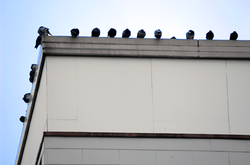 by Fran Prisco Pigeons that are a pest in our cities and suburbs across the Nation are ancestors of the Rock Dove. Rock Doves built their nests high on rock cliffs, very similar to our city buildings of today. Pigeon nests are made up of loose twigs and other material that is found nearby. Along with nesting material, pigeons also leave behind a mess with their droppings and molted feathers. Each year building owners spend thousands to get rid of pigeons from their buildings. Clean up FirstBefore installing any type of bird control system, it is important to do a thorough cleanup. It is best to power wash or spray bird droppings down and remove them while wet. Dried bird droppings can cause dust which when breathed in may carry any of 60 plus communicable diseases. Bird Droppings are also acidic and can quickly erode building and roofing materials, not to mention that they are a safety hazard on sidewalks, causing slip and fall accidents.
|










 RSS Feed
RSS Feed